Circle Tour—Closing the Loop
What are we doing
We rolled into Houghton, Michigan, wet with drizzle and burnt out from four straight days averaging fifty miles. A fifty-mile day isn’t any particular achievement as bike touring goes—a hundred would be—but being out in the wind, the occasional rain, the kind of autumn chill that soaks into your core, it was enough, and when we passed a coffee shop we unanimously decided to park the bikes and sit down. Cradling hot mugs full of comfort, we played cribbage and talked. “You guys,” Ava said. “We’re biking around Lake Superior. It’s so far. What are we doing.”
“You know, I was kind of thinking about that last night,” I said. Last night we’d camped out at a roadside park where two tannic waterfalls of the Tioga Creek crash down on their way to Sturgeon River and the Lake. The nice picnic tables and lawn were guarded only by a sign that said No overnight camping, which naturally none of us saw. “Why are we biking around the Lake? We never really talked about it when we started.”
It turned out we all had different reasons. Maria, for instance, after a tumultuous last year, had started settling back into a sense of balance in life, in part with the guidance and inspiration of the Lake, one presence she could be sure of, and was riding to spend closer time with a good friend. Ava, meanwhile, was riding to push herself: Ava is always attempting to do something more than she’s ever done, be better than she’s ever been. Before this trip the farthest she’d ever ridden a bike was about fifty miles. The trip ended up 1,425. When the question got around the table to Katie, she said: “Because I wanted to? And because I like riding my bike, and I like being with my friends.” And ever since she moved to Ashland for college (and then stayed), Katie’s held a pure and unironic love for the Chequamegon Bay’s little towns full of earnest hippies and other weirdos just figuring it out day by day, and the Lake that anchors them.
As for me, I was riding to learn—Lake Superior, it seemed, had been calling me, and to properly answer the call I wanted to see the whole lake, so I could begin to understand this massive spirit that’s drawn people inexorably to its shores ever since the glaciers left it. I’d seen a couple bays and a few towns, but stare as I might at maps, I knew I couldn’t begin to comprehend the true nature of the Lake without exposing myself to its size and all the places around it, as rawly as possible. When I first saw Lake Superior, it scared me, as big water always has since I first found my way from my landlocked origins to shores that had no visible opposite side. Biking all the way around the Lake taught me that fear is only one of many proper responses to it, including awe, love, humility, gratitude, and whatever feeling it is that a kitten has when it burrows into its mother’s fur. I was also biking to practice being a human: what better way to dig into the messiness of human relationships and the all-directions emotional winds that push them around, than to do something giant with three people I barely knew and just rely on my ability to listen to my own inborn humanity and everyone else’s?
And of course the reasons we talked about in the coffeehouse weren’t our only ones; we all had lots of reasons both explainable and too-subconscious. I think, in any case, we all got what we wanted. I know at least I did. One of many things I learned was that there’s not just one way to get to know the Lake. You can, of course, get to know it directly, by physically being on its shores and stepping into its waters. But you can also get to know it as filtered through the people who call it home: in effect, understand its spirit in translation. The North Shore in Canada lent itself to that first approach starkly and purely. Once we crossed into Michigan, along our route we started finding place after place to do it the second way.
Inverse Iceland
I should say something about the crossing. Lake Superior is a sort of inverse Iceland. If you go to Iceland, I’m told, and take the roads that travel the circumference of the island, every few miles you come to a waterfall making its way down from the glacial heights, waterfall after waterfall, little brooks and massive rivers all tumbling on down to the ocean. All around Lake Superior you find the same thing happening, only crossing under the road the other direction, all the water rushing toward this three-quarters-Iceland-sized hole. By the time we reached Sault Ste. Marie, we’d stopped and spent time at
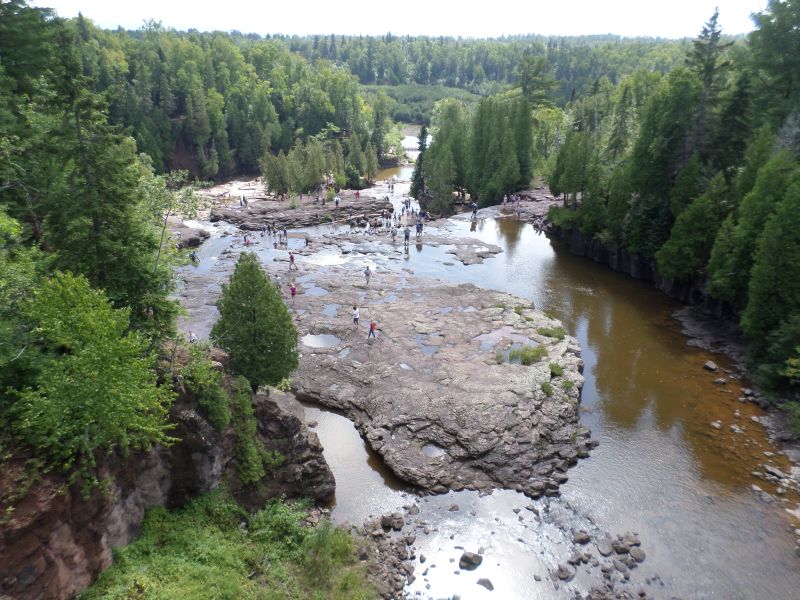
Gooseberry Falls, halfway up the Minnesota north shore, where we arrived the day before Memorial Day and found that about one in every five Minnesotans had come too, with their family, for one last summer hurrah;
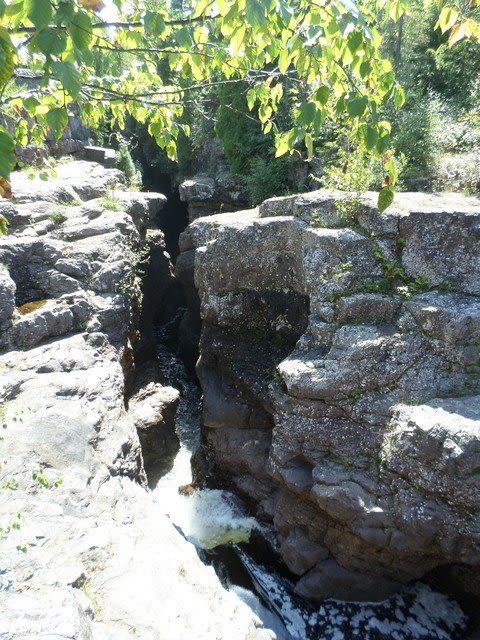
Temperance River Falls, where the river tilts sideways and churns through cauldrons of rock;
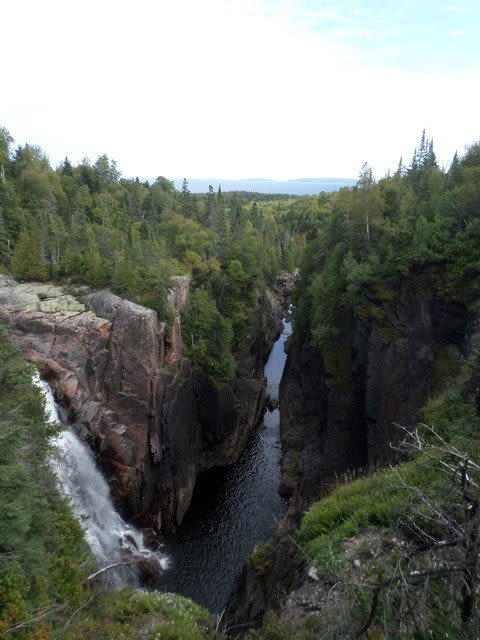
Aguasabon Falls, which must’ve been twice as impressive before they diverted half of it through a turbine (elsewhere), but still gives you a little attack of vertigo from the top;
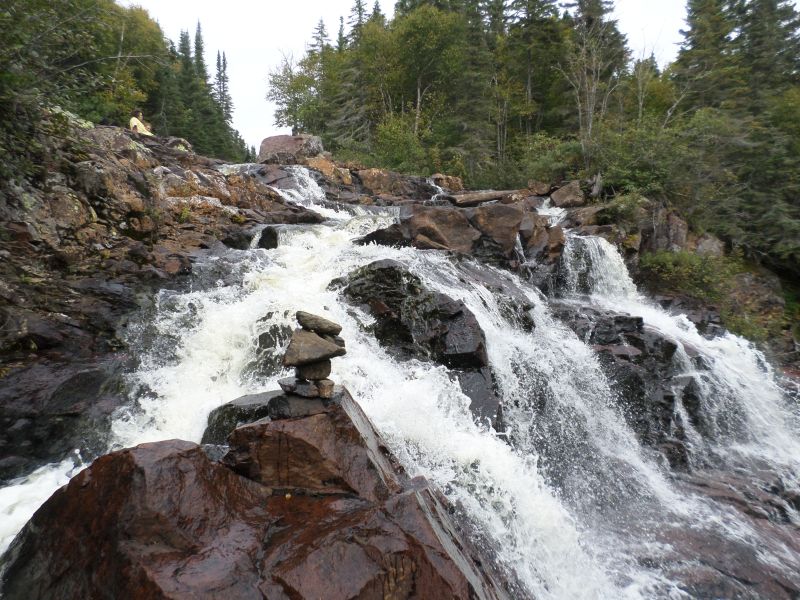
and Mink Creek Falls, a secret waterfall we’d learned about from Frank in Thunder Bay, which you come to by pulling off at an unmarked gravel parking lot in the middle of nowhere near kilometer 821 on the highway and hiking down a steep trail, and where everyone but me saw a bear crossing the stream down below the falls (I was exploring rocks slightly too far upstream, but it was okay, I’d seen a different bear earlier that day).
And that was just the ones we stopped at and that I took pictures of. The waterfalls were everywhere, constantly replenishing the Big Water from all sides. It’s a land of water here, marshes and mountain brooks and minor lakes draining through nameless streams, and Lake Superior is where it all comes to gather.
And yet with all those uncountable pourings-in, all that water has only two ways out: back into the sky, and through the Sault of Sainte Marie, the St Marys Rapids, where the corner of the lake pours through St Marys River and down a broad, boiling, rocky twenty-four feet on its short trip to Lake Huron. The bridge across it is nearly three miles long, narrow, and windy, and the night before we crossed it a cold front came through and hacked twenty degrees off the temperature, sending us digging for jackets and gloves that we’d only dimly been able to imagine using back in August. But as soon as customs waved us through we got our reward for dealing with the mountain highways of Canada: now, suddenly, there were back roads, not just a single giant highway, and it was flat, and we could breathe while riding again.
Just what you didn’t know you needed
And, as I said, there were people around too, the quietly rugged kind of people who line the shores of a Lake that can hurl at them them over two hundred inches of snow, temperatures of –35° and lower, and November winds that blow water up over the roads, people off their feet, and freighters like the Edmund Fitzgerald into the deeps. Like the couple running the little grocery store in Brimley, who told us as though we were old friends that when we got to the Dancing Crane Coffee House a few miles further on we should try the chocolate chai and the Thirty Below (frozen hot chocolate).
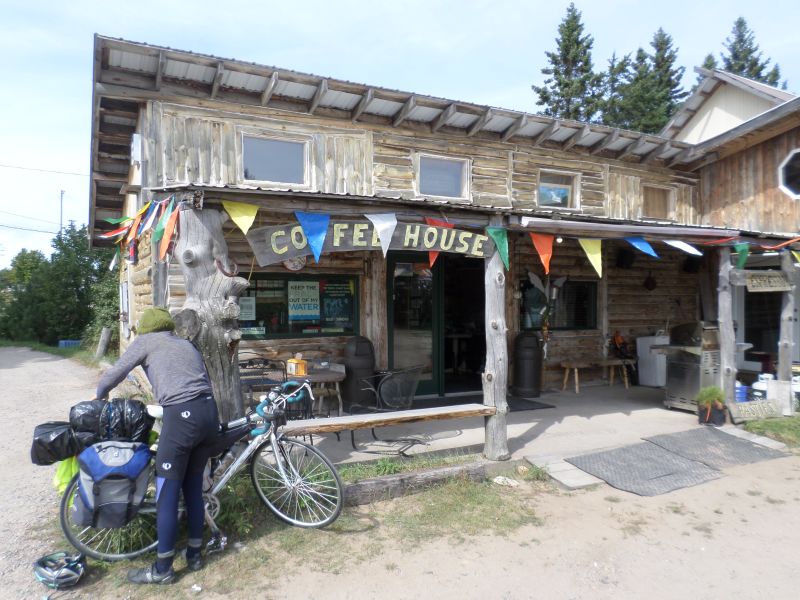
The Dancing Crane is one of those rarest of places, a good coffeehouse that pops up in the middle of nowhere right when you want to be warm and comfortable. It’s run by a family from the nearby Bay Mills Indian Reservation, who have lined the lively wooden walls with just the sorts of books that I could sit and read for a week, and for being back of beyond it seems to do pretty lively business. When we got there, one of the locals hanging around chatting on the couch in the back turned out to be the grocers’ daughter. The chai was hot and delicious, and the people were real and kind, and when we got back on our bikes we had pep in our pedaling that didn’t come just from caffeine.
The next day, after disappointments in Paradise (which turned out to be full of retirees who seem to have no further goals in life than getting their desires catered to in the town’s two cafes by cheerless waitresses and slowly rotting away before your eyes) and Tahquamenon Falls (where a decent-enough waterfall has been tastelessly decorated with crowds of car tourists milling around with ice cream cones), evening found us riding along through a tunnel of green leaves now beginning to show signs of yellow and red, surrounded by impenetrable marshy forest, discussing where we might camp. There were no official campgrounds in range unless we pedaled on into dusk, and we were all tired and hungry. Our best and only plan was to just keep riding and hope something appeared.
And lo, in a little clearing, there appeared the North Star Brick Oven Bakery. I suddenly remembered it from a recommendation we’d gotten, something about the “best sourdough you’ll ever have”. The sign said they were ten minutes from closing. We hurried in, into air rich with yeast, garlic, and soft warmth. In back an elder couple was at work, Paul pulling loaf after loaf of sourdough out of a wood-fired brick oven, Joanne counting up money and arranging papers.
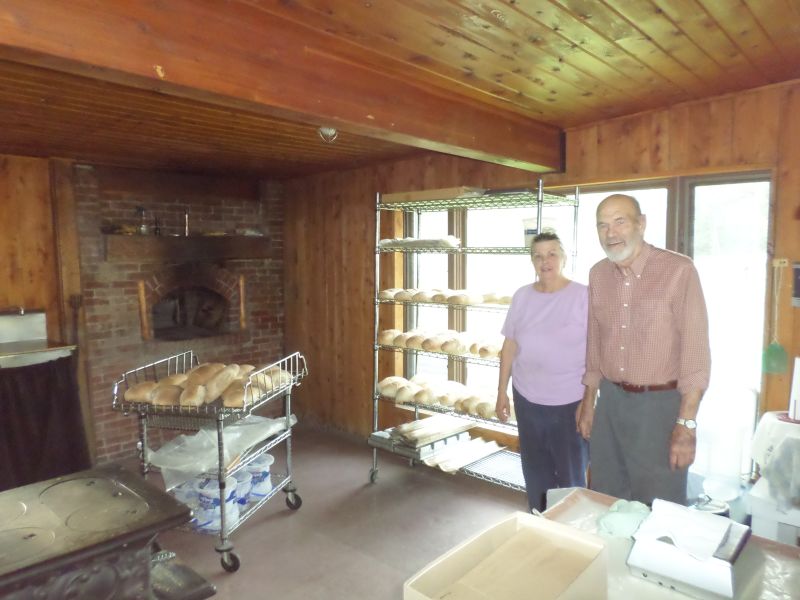
They started this bakery eighteen years ago, after Paul had had his fill of working for restaurants. He built the oven himself and then the store around it, and since then they’ve just kept baking. Some days they turn on the generator, some days they just work with no electricity. “Where do your customers come from out here in the middle of nowhere?” I asked. We were thirteen miles from the nearest town, itself a nowheresburg, and sixteen from any sizeable highway; their neighbor on all sides was dense pine-maple forest. “All over the world,” Joanne said. “You wouldn’t believe where people come from.” Before getting any bread, we asked our most pressing question: where could we camp? After Paul got done emptying the oven, he talked through the nearby possibilities, concluded that there were none, and said, “Well, you could sleep here.”
That settled, we bought three loaves of sourdough and a little bottle of olive oil and went out into the yard, where before anything else we sat down on the ground and devoured an entire loaf like four puppies eating from the same bowl. We set up camp and our night was charged with the bread smell wafting out of the chimney until a morning rain came and washed it away.
Warm and cozy
The next day we saved ourselves fifteen miles and a trip away from the lakeshore by shortcutting down the Grand Marais Truck Trail, which follows the shore for eighteen miles, twelve of them unpaved. It seemed like an eminently reasonably decision, and we came to the edge of the pavement in high spirits. Then it turned out the road wasn’t gravel but sand. And it was consistently washboarded. And then it started raining. As the sand worked its way up from the road in wet globs into our chains, brakes, and gears, our spirits and our faces sagged. The smiles you can see here were possible only because we had just made it back to asphalt:
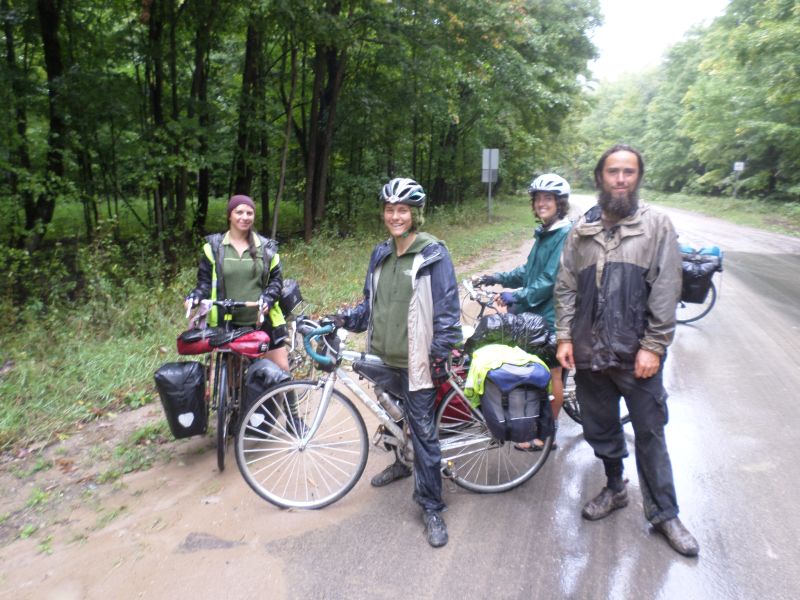
L→R: Maria, Ava, Katie, me. Taken by a guy who drove by in his pickup and stopped to offer us pity.
We ground our gears the last mile into Grand Marais, soggy and caked in sand, and stopped at the corner gas station, a little been-there-forever building, to be somewhere warm and figure out what to do next. There was a campground, we’d heard, but we’d also been getting grave warnings since Tahquamenon Falls about a storm that was supposed to bring gale-force winds soon, and, well, we were kind of miserable too at this point. The guy at the counter, a good-natured talker unperturbed by four cyclists dripping wet sand onto his floor and using the bathroom without buying anything, told us about the campground a mile away with sites around $35—and then pointed out the hotel just across the street with rooms starting at $40. “They’re real nice people there,” he told us.
Back in Grand Portage, Minnesota, Katie almost bought us a hotel room on a rainy day, but we’d finally decided it wasn’t worth it and camped instead, rewarding ourselves for the forbearance with the promise that we’d take a hotel day later. Tonight we cashed in. The Superior Hotel is a hundred and fifteen years old, not too much younger than the town itself, and the owners, Mary and Rick, are the third generation to manage this place. The table in the kitchen has seen hundreds of rowdy parties over the years; in the old days, Mary told us, if a lumberman saw a truck out front of the hotel, he’d come in to talk to his friend, and so would the next lumberman who noticed their trucks, and the next, until the place was full. Nowadays the lumbermen are gone but locals still occasionally accumulate in the same way. The floorboards upstairs creak with the weight of a hundred and fifteen years of feet and memories. The rooms, upstairs, are like the spare bedroom at your grandparents’ house, except with more beds (ours had four packed in), and all twelve of them are served by two bathrooms at the end of the hall. Rick and Mary also edit the town’s paper, which in lieu of news is mostly full of reprints of headlines from all the years since the town was founded, as well as old-timers’ reminiscences and chapters from old children’s books, like The Teenie Weenies, which features a family of people as tall as your thumb who live in a pickle barrel, and inspired someone to build the following for its author, who lived nearby.
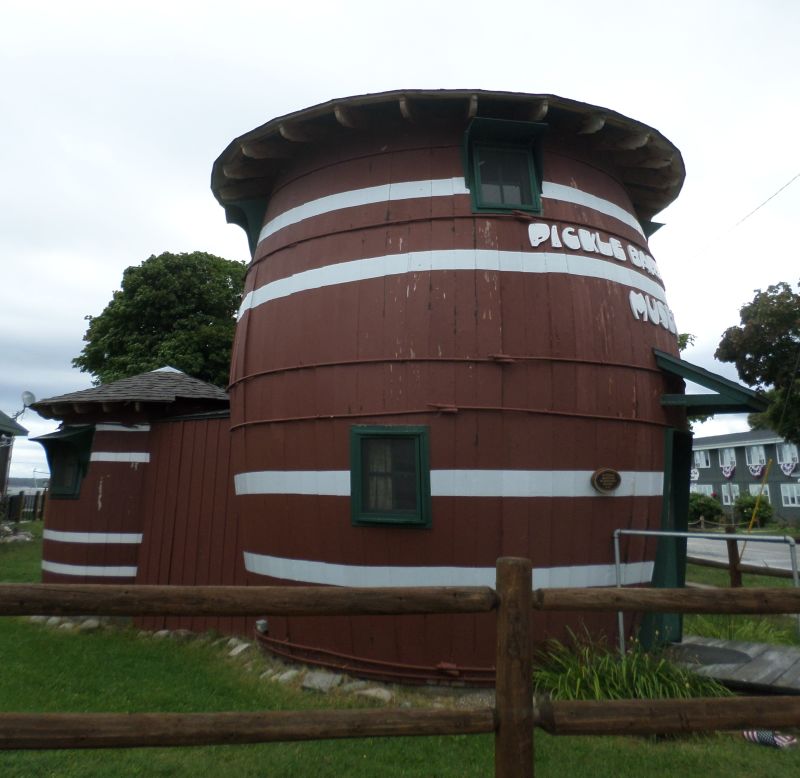
We peeled off our sand-wet raincoats (soaked through, thanks so much), and showered lavishly, and Mary let us cook dinner on their real-ass kitchen stove. We got that special kind of sleepy you only get when you’ve been cold for a long time and suddenly you’re very warm and everything is soft and cozy and you’ve gotten a good cup of chamomile tea and my, is it fuzzy in here or is it just my mind?
The wind, people told us, would be starting around midnight. I was the first awake, somehow, around eight—generally, Ava was packed up and had breakfast nearly ready by the time any of the rest of us dragged ourselves out of our sleeping bags—and when I went outside the air was calm, warm, a nice day. Gale force storm, more like a lot of hot air.
Before getting going we accepted Mary’s offer of a hose to get the sand out of our bikes’ crevices. Maria, the most meticulous of us about bike maintenance, was still at it around 11:30, and I got to wandering around town. The wind was picking up a bit, is what I was noticing. So I wandered my wander on out to the lake. And here I discovered what a gale is. A gale is the hard steady inescapable breath of Mishibizhiw blown directly into your face. I stood on a boardwalk and sand got whipped against my lips from seven feet below my head and the lake’s surface had turned into a sideways waterfall and if I turned around I could nearly lean on the wind. I could only stay for a couple minutes before the sand stinging against my face drove me back. The wind whipped my walk up into a little dancy jog. I found Katie and Ava having lunch at the tavern, and I proposed we wait until tomorrow to leave. It was a particularly easy decision and when we found Maria she agreed too. If we’d tried to ride, we might’ve made it five miles, and it would’ve felt like thirty. Instead we all spent the afternoon relearning how to play cribbage.
We took a walk all together out to the lake, where the wind had just gotten stronger. I climbed down off the boardwalk and rescued a guy’s hat after it got whipped off his head and landed twenty feet away. We got as close as we dared to the waves, which by now were as tall as us.
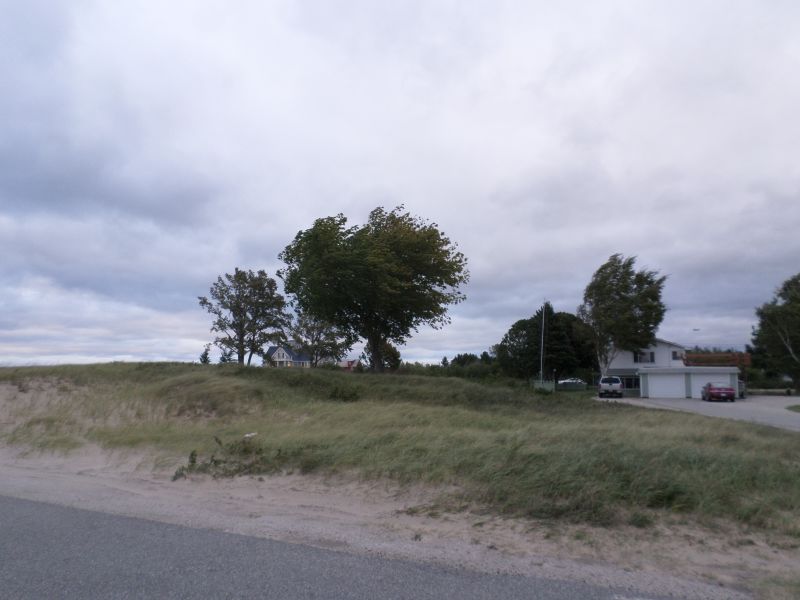
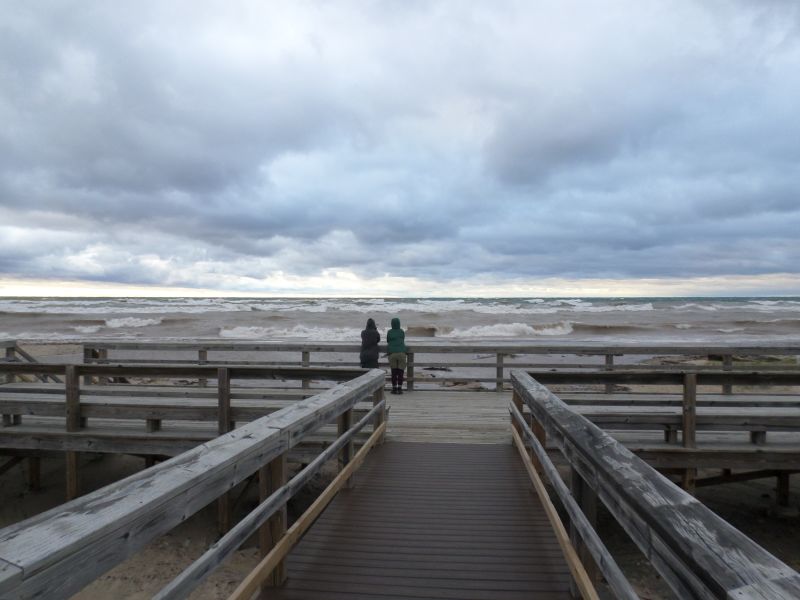
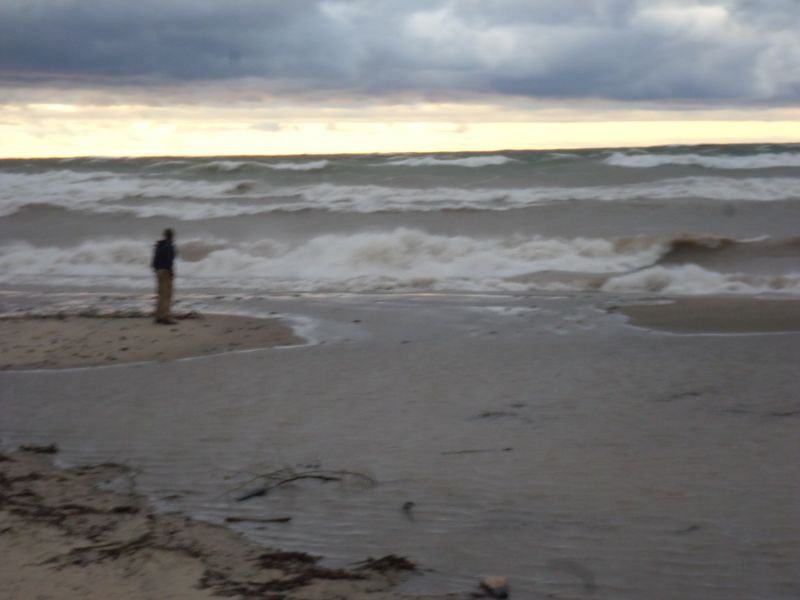
An older guy joined us down on the beach, howling into the wind. “I’ve never seen it blow like this, and I’ve been here for six years! Never been down here for it!” He wore a tightly fastened hat, three layers of pants, and homemade sheepskin boots. “I kayaked in something like this once, off the coast of Oregon!” He took pictures of us and I took one of him.
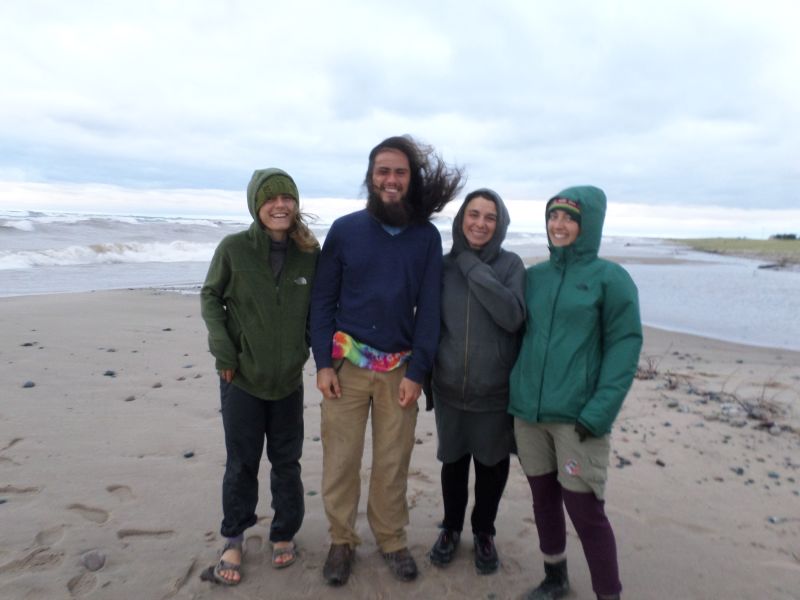
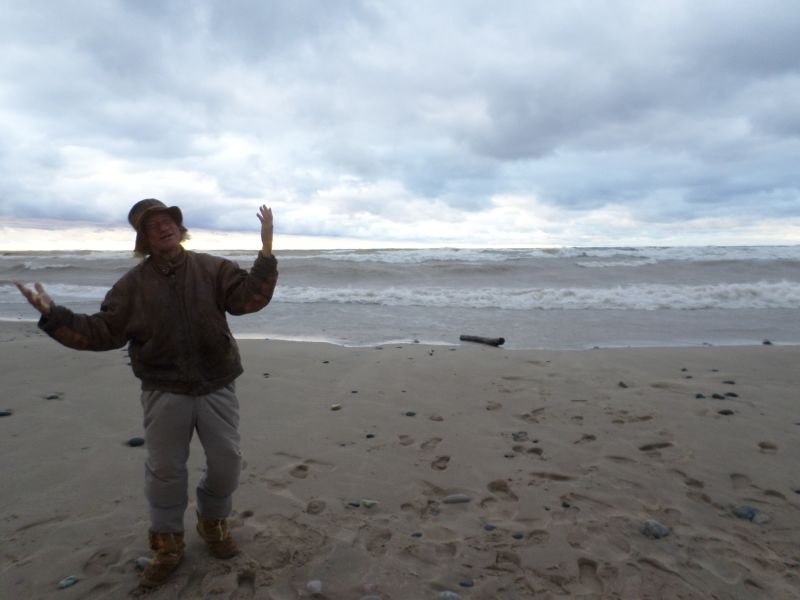
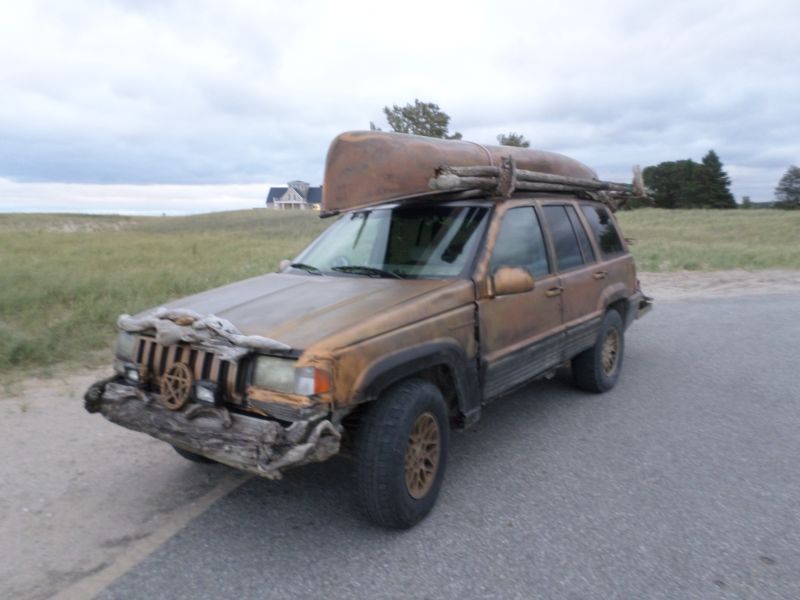
And of his car. Note driftwood bumpers and pentagram on the grille.
By the time we got back, the power was out through the entire town except,through some fluke, the Tavern, and everyone in town was there. We joined the line, but when we were about halfway to getting seated, all the lights suddenly shut off and the kitchen went silent beneath the din of the crowd. So we cooked spaghetti on the Hotel’s stove, which thankfully runs on gas, and went to bed shortly after the sun did.
Little hard-to-pronounce metal towns
In Munising (/myū·nĭs·iŋ/) Maria and I made our visit to the UP official by getting pasties (that’s păsties)—calzone-shaped pie crusts full of beef, potatoes, and rutabagas, invented in Cornwall by coal miners’ wives and, for reasons I’ve never understood, a mainstay in this region full of the descendants of Finns. Something about the mines, maybe, though here they’re mostly for iron. One thing I can say, for my money they’re about the best bike fuel there is. In Marquette we stayed with college students at the Climbers’ Co-op, a previously abandoned house now fixed up and fitted with a bouldering room. It may have been cleaner when it was abandoned, is my take on the college-student approach to tidying up, but the people there were friendly in what moments they could spare from homework to hang out with us, and they always have a spare bed for bike tourers. We rode the fifteen miles from there to Ishpeming along a trail put together from the old railbeds and mule trails they used to use to haul iron into town, and as a train of little cars full of taconite pellets lumbered by on a stretch of track still in use, I showboated with a quick jump onto the ladder.
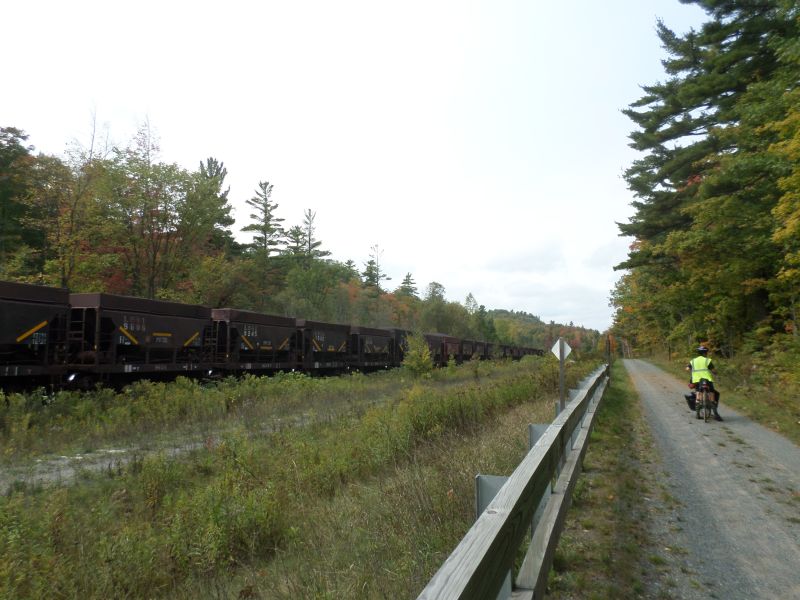
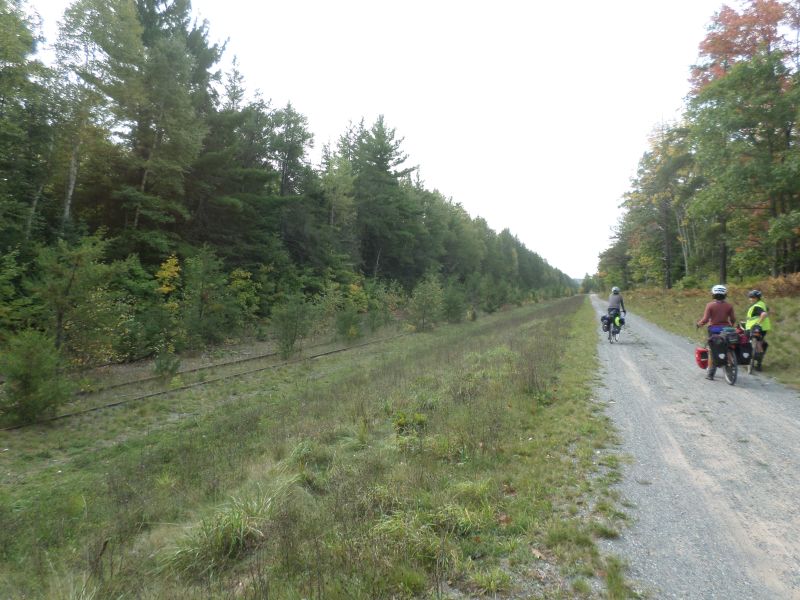
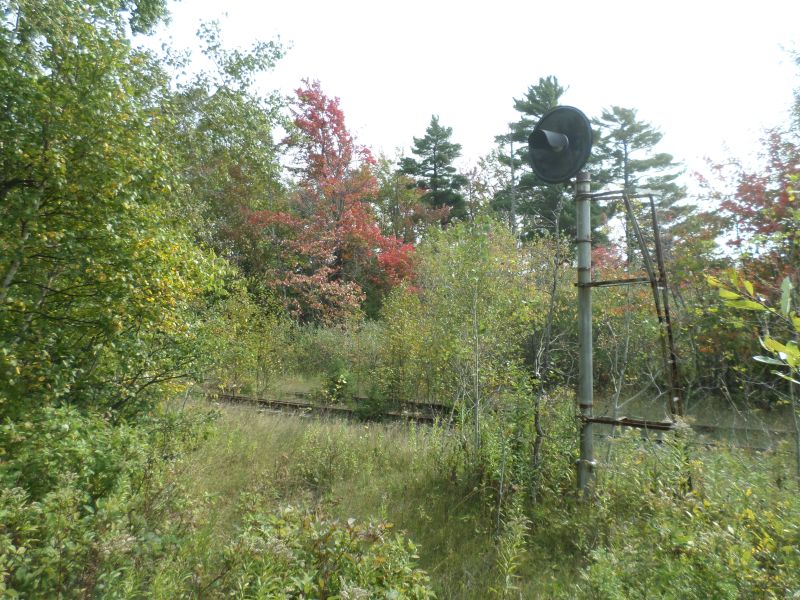
Just outside the little town of L’Anse (/laanss/) we happened upon a farmers’ market selling fruits and veggies at surreally cheap prices, we’re talking a dollar for a zucchini the size of an infant. “Are we in heaven?” Katie asked, and we loaded up with apples at $1.69/lb.
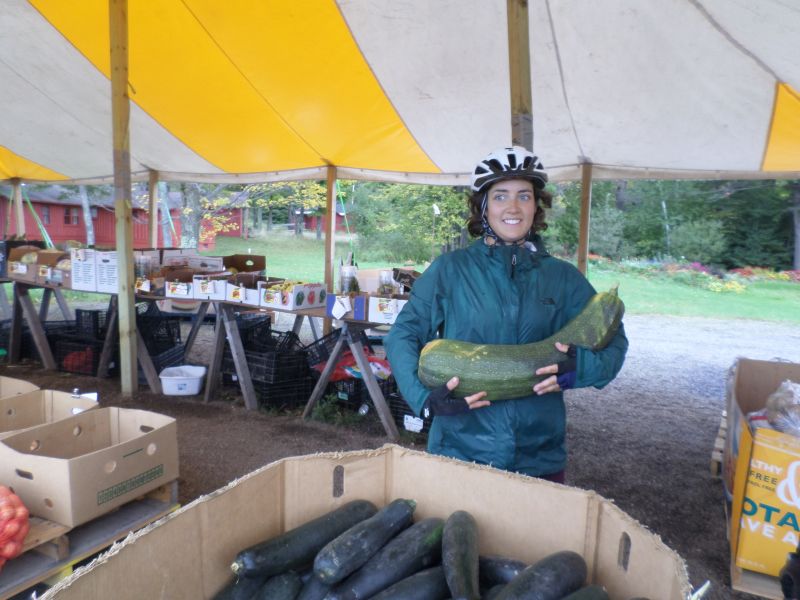
Houghton (/hōt·’n/) is built more or less onto the side of a cliff, with the help of engineers from its mining college who weren’t working on building copper mines nearby, and the streets run precariously up it, and at the top we found Jeremy’s house. Katie found Jeremy through Warmshowers, a website specifically for cyclists looking for someone willing to host them for a night on long tours. We got to his house before he did, and decided we liked him when we found that he’d put post-its all over his house (“Dishes in dishwasher are clean,” “This counter is not strong enough to support a human’s weight,” and on his bedroom door, “Back off hippie!”). We liked him when he got home too, and a night in his house was just what we needed after another cold wet day.
That spiky bit on the map
We’d been looking forward to the Keweenaw Peninsula (/kē·wĭ·naw/) since the beginning of the trip. I’d never heard of it, but the others had, and had always wanted to visit it, and when after a rough day in Canada someone—probably Katie, who’s famously a fount of conversation-starting questions—asked, “What place are you looking forward to?” I remember everyone being excited about the Keweenaw. Which made me excited too. It’s a hitchhiker-crooked thumb that juts almost halfway across the lake, the kind of place where you can’t hustle or bustle because there’s too much silence blowing in off the water. It welcomed us with the first real tailwind of our trip and roads we got practically to ourselves through impossibly picturesque farms and some of the first spectacular colors of fall.
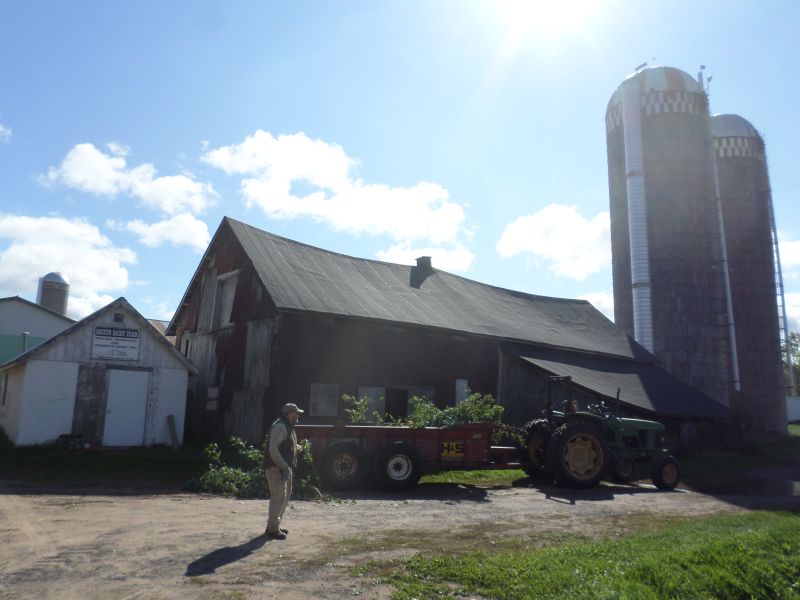
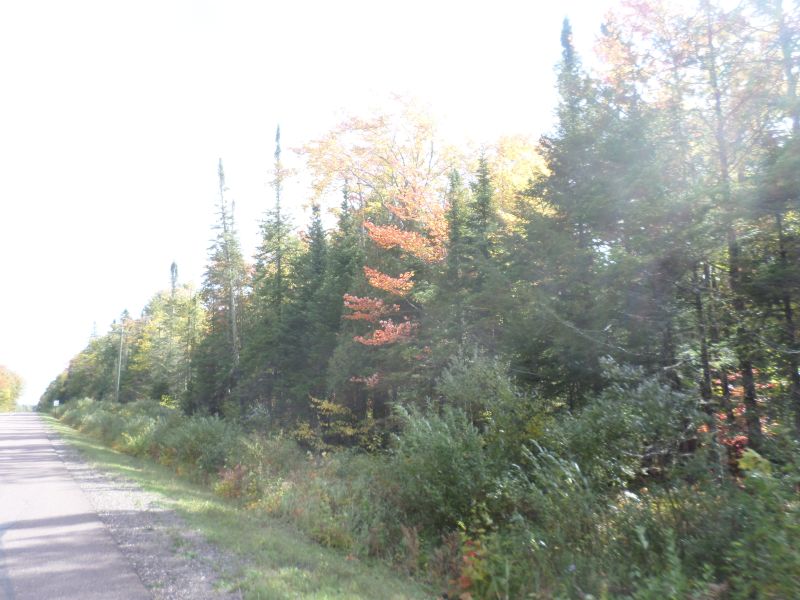
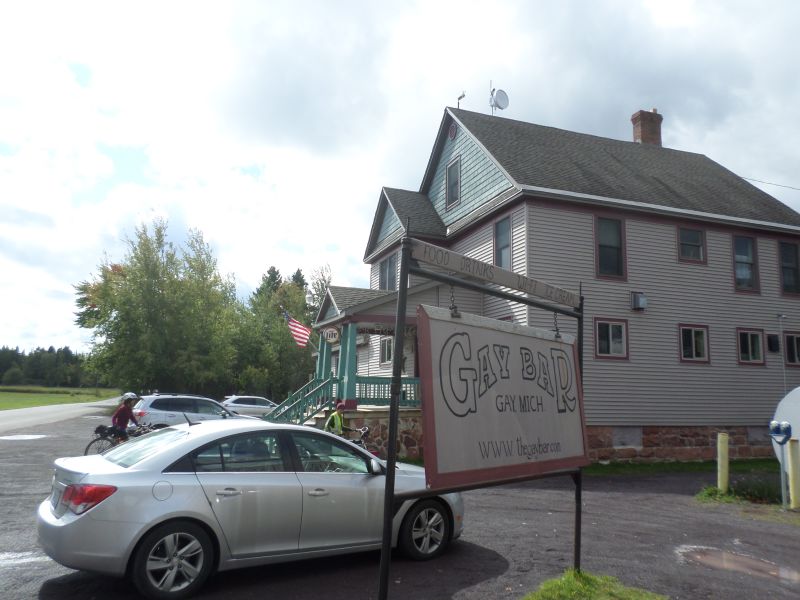
In the town of Gay, we stopped off at the Gay Bar, which makes a little bit of side money selling raunchy T-shirts but mostly caters to old locals who sit around the bar talking about ATV engine specifications. We got kicked out for not buying drinks, by the sole employee, an irritable woman who evidently had decided we weren’t going to buy anything even though we were planning to. Thought they’d be more understanding at the Gay Bar. Instead we ate in a pavilion next to an apple tree and the Gay School.
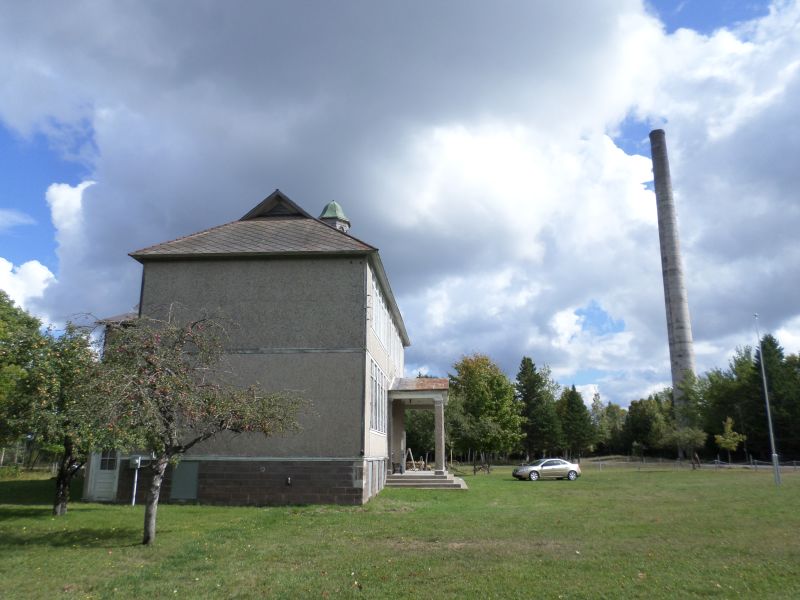
Our way up to the tip of the peninsula was marked by the kind of perfect scenes you don’t expect to see outside of a painting.
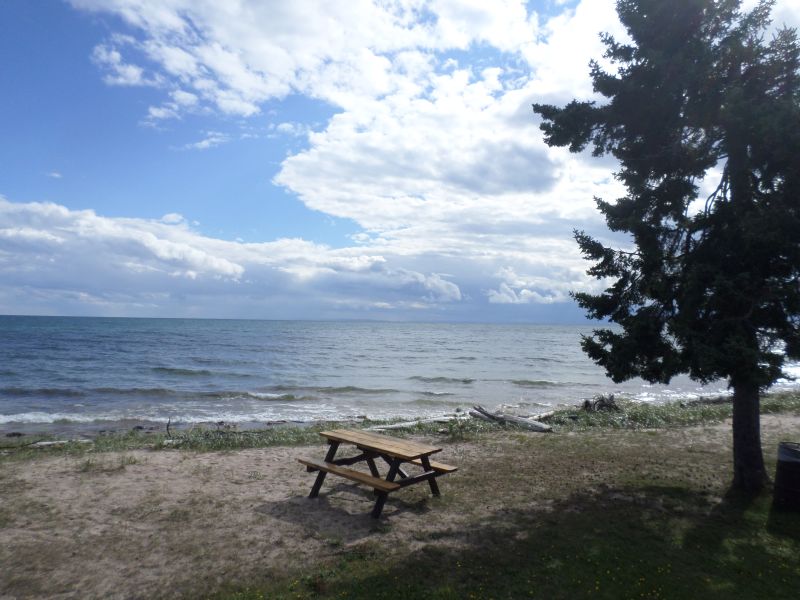
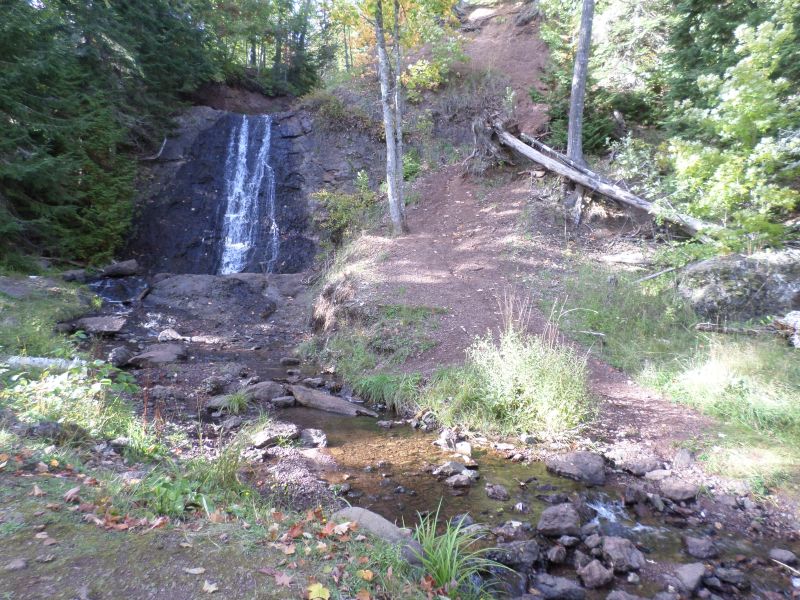
Never mind that there was a four-mile climb in the afternoon and by the end of the day a heavy chill had settled on top of us and frozen our fingers so we could barely get dinner made. We still counted it a perfect day. The next day was colder and wetter, but salvaged almost singlehandedly by the presence of a gold-domed Ukrainian Catholic skete where the long-bearded, black-robed, calm-voiced monks get by nicely by making pastries and jam of wide renown to sell to passers-through—we made it there before the rain reached us and spent a while at their picnic table eating the biggest muffin any of us had ever seen. And anyhow we got to warm up and dry off from that soaking final stretch at Jeremy’s when we stayed with him again that night.
Company
On the last leg of the trip, we rendezvoused in the Porcupine Mountains with Ava’s dad Tim and her boyfriend Leo. Leo had brought Tim and his bike so he could ride the last two and a half days with us. Now, we’d been through our modest share of difficult moments as a group—those moments when Katie or Maria were too demoralized with the raw difficulty or the little thorn-in-shoe interpersonal hardships to continue, or Ava was at a limit of frustration with how we could never seem to get started early or just crank out miles, or I got pangs of sadness as we passed right by another nice spot where I’d have dillydallied, in the name of finishing the trip before mid-October—but we’d come through them into a mature coherence as a group where each of us balanced what we wanted with what everyone else wanted, and I came to appreciate the differences between us for their ability to highlight things I wouldn’t have noticed. But no matter how much we liked each other, I’ve got to say it was nice to have some company besides the same few people we’d been with for the last month. Oh, and another bonus to this scheme was that Leo works in a restaurant and, recognizing that his role as the driver was the cushiest gig, he compensated by cooking us awesome dinners and breakfasts for the two days we were around him. Now we found we were starting to ease back into our regular lives: food closer to real (more vegetables, less peanut butter), people we knew, and even a little bit of unladen riding as Leo ferried our stuff twenty-five miles from one end of the park to the other.
As mountain ranges go, the Porkies just barely merit the name, at twelve miles long and a highest peak not quite 2,000 feet high. But they’ve got some other things going for them: for one, they’re covered in the largest virgin stand of hemlock-hardwood forest west of the Adirondacks, preserved from the ax, as Maria tells it, through the efforts of one far-sighted conservationist in the early 1900s who put down his foot and told the loggers that they’d taken everything else but they must not take this place. I dimly knew hemlock trees can get big, but I’d never seen one I couldn’t wrap the fingers of my two hands around. Here they shared the rule of the forest with maples, and I felt strangely proud to see them doing it. The old trees cast a quiet, eternal shadow on the mossy forest floor. Also, there’s the Presque Isle River, which descends to the lake through a series of three frothing, leaf-brown falls named after Anishinaabe spirits, and clearly holy places, cutting sharply through the rock, with cedars leaning out over them.
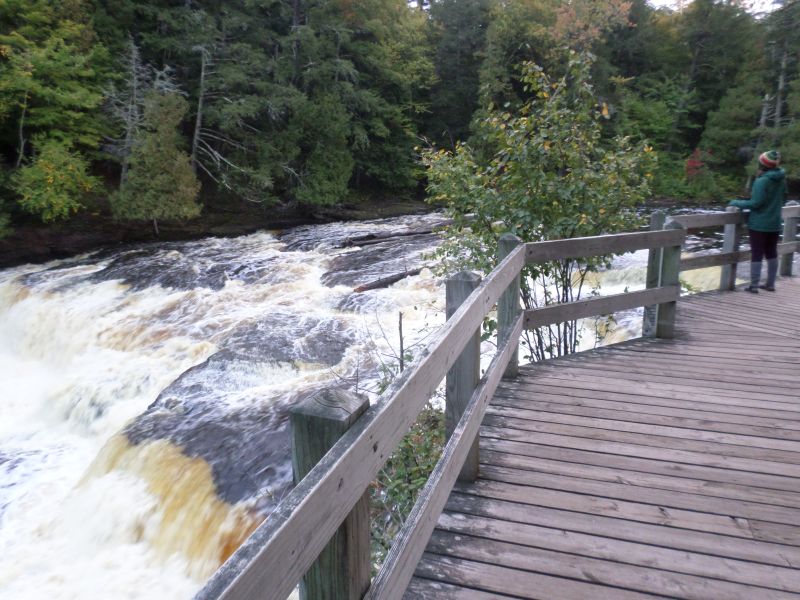
Wenabezho Falls (Wenabezho is an alias for Nanaboozhoo).
Tim, with the help of a nifty new electric-assist bike, kept up with us younguns plenty well enough to leaven our usual conversation topics with dad jokes, and built fires for us at night, and made the continuing dim raininess a little bit brighter for the last couple days.
Despite the overcast, the fall colors reached yet unseen intensity and the empty back roads carried us on invitingly. We finally rolled into Ashland, through the bike trail, around 3:00 on the drizzly first of October, the five of us, and went straight to the Black Cat, the coffeehouse, the mecca of all that is good in Ashland, and did what we’d been needing to do for a long time now: settled our cribbage tournament.
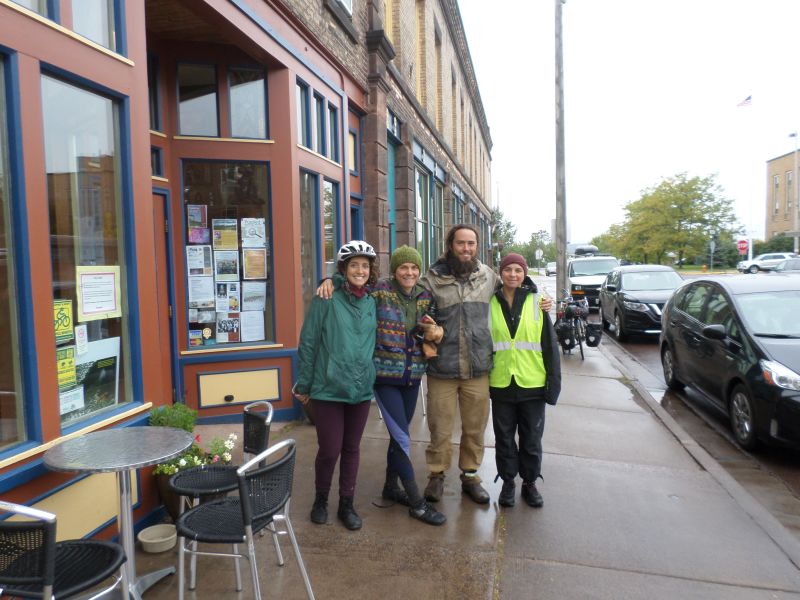
Outside the Black Cat, spiritual terminus of the journey.
With the eight final miles back to the country house we started from, we closed the loop we’d been tracing for the last thirty-four days, a fourteen-hundred-twenty-five-mile circle around the biggest lake in the world, through two countries, three states, one province, over billion-year-old gneiss and granite, across uncountable waterfalling streams, out from one season and deep into another, acquainting ourselves with vast swaths of perfectly unknown land, and crunched our tires back across the same gravel we’d crunched out on.
And that was it. All done. Thanks for playing. It’ll be time for dinner soon.
It was weird to be back, weirder still, I’m sure, for Katie and Maria, who actually live in the Chequamegon, to have done this big thing, and now be back where everything is normal and familiar and there’s a next day to be contended with that doesn’t involve any more pedaling and hey, isn’t someone going to congratulate us or something?!
Turned out, yes. Some friends of Katie’s and Maria’s pulled together a last-minute potluck that was surprisingly well attended. We got to sit around a campfire with friends, talk about our favorite moments along the trip, compare notes with a guy who’d ridden the same ride (and jogged it a few years later, holy shit), drink beer and wine and eat good food, talk about things entirely unrelated to the bike trip, and get the warmth of home we’d been hoping to find.
In the days since, we’ve scattered somewhat, back to our separate lives. I’m still the same person I used to be, more or less; for the moment, I’m back to the same room I was crashing in before the trip started. But now when I go to the Lake here and watch the creek flow in through the marsh or the wind blow sand up over the road, I know where I am.
File under: biking, Year of Listening, photos, friends · Places: Midwest, Chequamegon
Note: comments are temporarily disabled because Google’s spam-blocking software cannot withstand spammers’ resolve.
12 Comments
Dave
HistoryEpic adventures! I’ve always been fascinated with Lake Superior too. A couple of things I learned about it; it is the largest failed Rift Valley. It could have been the Superior sea, or Superior channel if it had succeeded in splitting North America in two. It also has a hydrological retention rate of 191 years. So undoubtedly you took a leak in the lake or one of it’s many rivers emptying into it. Your contributions will stay for generations to come. By comparison, the diminutive Lake Erie drains in a scant 2.6 years.
I did enjoy Grandma’s marathon, which runs point to point, right along the lake from Two Harbors all the way to Duluth. I’m planning on doing it again this next summer.
Chuck
HistoryI didn’t know about the rift valley, that’s pretty cool. I was trying to find some information about how it originally formed the other day. For a while I thought the whole thing was carved by the last round of glaciers, but something told me there must be more to it. Where did you learn about the rift valley? One of my favorite facts is that it has more water than the other four Great Lakes combined.
I haven’t run Grandma’s, but I’ve eaten there with Dan’s family. Good onion rings.
Dave
Historyhttps://www.nps.gov/articles/parkscience32_1_19-29_stein_et_al_3817.htm
There are lots of good articles on the Internet about it.
Chuck
HistorySomehow all of them eluded me when I was trying to find them. Thanks!
Verne Troxel
HistoryGrandma and I have seen some of this but not nearly as Close, with all of the smells and sights thru bikimg. Fit, I declare ye ‘fit as a fiddle’. In addition, I challenge you to a cribbage game, perhaps your Uncle Howard, cousin Carrie, you and I can have a round robin tournament in Crow Duck next yea, if ya’ aren’t skeered???? Your trip description transported me to a different time, a different place and certainly a different age. For that I thank you.
Chuck
HistoryGlad I could take you somewhere interesting. As for the cribbage: Aw, you goin down.
Gabe
HistoryBeautiful! Congrats!
Ava Kay
HistoryNathanael, What a lovely gift it is to read this! It makes me so grateful for the art of story telling that you are so well acquainted with!! Reading this made me laugh and miss our little temporary riding gang. Nice to recall those days of getting comfy cozy =) AND Katie is totally a fount of conversation- spot on description and I like that word, fount.
I wanted to get in touch with you to because i never got to say good-bye as it did seem you did disappear without announcement. Anyway, wanted to wish you luck on your next endeavor, and i hope Chequamegan bay becomes one of your many homes so that our paths will cross more often. I am curious about your next move, any news on line 3?
Dont be a stranger hobo, Ava
Chuck
HistoryHey Ava! I haven’t heard back from the Line 3 folks, apparently it takes them a while sometimes because there’s not really any, whatchacallit, electricity at the camp. I’m glad you liked the story—it’s nice to have this stuff written down somewhere to keep around.
Didn’t realize it seemed like I just disappeared. (From my perspective, I was right there the whole time.) But I guess we didn’t really say much of a goodbye at the party that night, and then I expected I’d see you to give back your cookware, but by the time I got to town the next day you’d already up and headed to Door County… in any case, settling down at the Chequamegon Bay is my current plan, so whenever you make the trek back we should be able to hang out.
Mom
HistoryI didn’t want this entry to end. Mom
alfi
HistoryWhen someone else might use a easier approach to see nature, as going somewhere with cars, you guys chose the best way to experience it. Also reading your blogs (like i said million times) showed me that life is not just about getting a job, getting a partner, having a family. but it is also how we understand our existence, our nature, etc. While I am typing this, I already got my result of my thesis presentation and I didnt get the good result. But I will never make the result of my thesis control my life. I learnt from your adventure and my own experiences that things dont always work like we expect. But always there is a suprise there. Let me read the next story hehehe
Chuck
HistoryAugh, I’m sorry to hear about your thesis. I know you’ve been working hard at that for a long time—it doesn’t define you, but it’s never nice to have the feeling that you’re not good enough. It sounds like you’ve got a pretty good internal compass that lets you feel fulfilled on your own terms, though, no matter what the Korean education system thinks. Which is good, because the Korean education system’s standards are weird, arbitrary, and inhuman, at least if my experience with the primary schools is anything to go by. What’s next for you?
(Hmm… it’s Christmastime here, and while I’m thinking about gifts, maybe I can think about something to send in the mail your way…)